The Automotive Water Separation Systems Market is estimated to be valued at USD 1.3 billion in 2025 and is projected to reach USD 3.1 billion by 2035, registering a compound annual growth rate (CAGR) of 8.9% over the forecast period.
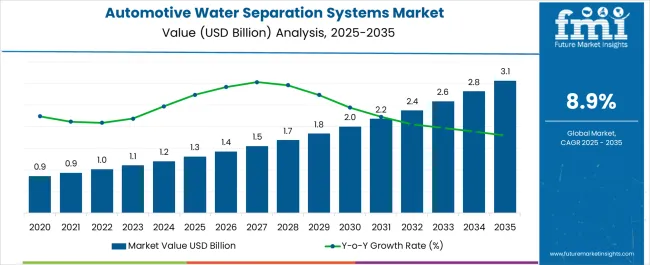
| Metric | Value |
|---|---|
| Automotive Water Separation Systems Market Estimated Value in (2025 E) | USD 1.3 billion |
| Automotive Water Separation Systems Market Forecast Value in (2035 F) | USD 3.1 billion |
| Forecast CAGR (2025 to 2035) | 8.9% |
The Automotive Water Separation Systems market is witnessing significant growth driven by the increasing focus on vehicle efficiency, engine longevity, and emission control. The market’s future outlook is shaped by advancements in engine technology, stricter emission regulations, and rising consumer demand for reliable automotive components. The integration of water separation systems in vehicles enhances fuel system performance by preventing water contamination, which can otherwise lead to engine damage and reduced efficiency.
Increasing production of passenger cars and light commercial vehicles across developed and emerging markets is further fueling demand. Additionally, growing investments in automotive safety and maintenance solutions, combined with the rising trend of vehicle electrification and hybrid engines, are creating new opportunities for water separation technologies.
Continuous improvements in materials and filtration technologies are enhancing system durability and efficiency, which supports market expansion As the automotive industry prioritizes performance, sustainability, and regulatory compliance, the adoption of water separation systems is expected to continue rising, particularly in segments focused on high-reliability engine operations and long-term vehicle maintenance.
The automotive water separation systems market is segmented by sales channel, vehicle type, and geographic regions. By sales channel, automotive water separation systems market is divided into Original Equipment Manufacturers (OEM), Original Equipment Supplier (OES), and Independent Aftermarket (IAM). In terms of vehicle type, automotive water separation systems market is classified into Passenger Car Automotive Water Separation Systems, LCV Automotive Water Separation Systems, and HCV Automotive Water Separation Systems. Regionally, the automotive water separation systems industry is classified into North America, Latin America, Western Europe, Eastern Europe, Balkan & Baltic Countries, Russia & Belarus, Central Asia, East Asia, South Asia & Pacific, and the Middle East & Africa.
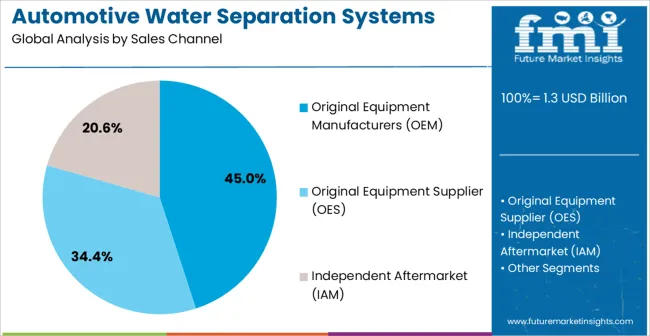
The Original Equipment Manufacturers (OEM) sales channel segment is projected to hold 45.0% of the Automotive Water Separation Systems market revenue share in 2025, making it the leading sales channel. The dominance of this segment is attributed to the strong integration of water separation systems directly into vehicles during production, ensuring high-quality installation and system reliability.
OEM adoption allows manufacturers to maintain compliance with stringent emission standards and enhances overall vehicle performance by preventing fuel contamination. The segment has also benefited from increasing partnerships between automotive system suppliers and vehicle manufacturers, enabling tailored solutions for various vehicle models.
Additionally, OEM channels are preferred for large-scale deployments as they provide standardized quality control, warranty support, and easier aftersales integration These factors collectively reinforce the growth of the OEM segment and its continued dominance in the market.
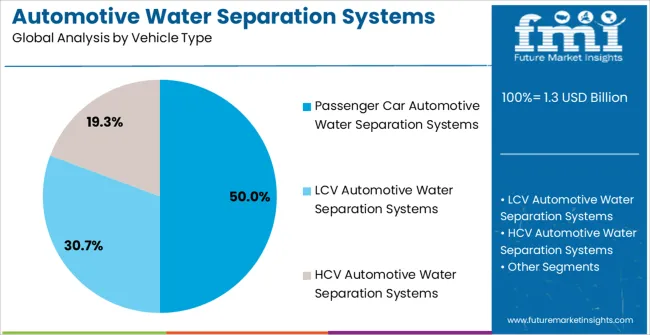
The Passenger Car segment is expected to capture 50.0% of the Automotive Water Separation Systems market revenue share in 2025, positioning it as the leading vehicle type. The growth of this segment is driven by the high production volume of passenger cars globally and the increasing emphasis on engine efficiency and longevity. Water separation systems in passenger cars are critical for maintaining fuel quality, preventing corrosion, and reducing maintenance costs, which supports widespread adoption.
Additionally, the segment benefits from growing consumer awareness of vehicle performance and reliability, coupled with regulatory mandates on emission and fuel system standards. Technological advancements in compact and efficient water separation systems have further facilitated integration into passenger vehicles without compromising design or performance.
Rising urbanization and increasing vehicle ownership in emerging markets also contribute to the segment’s expansion The combined effect of production scale, regulatory compliance, and consumer demand ensures that passenger cars remain the dominant vehicle type segment for water separation systems.
Automotive water separation system is a device that is used to ensure the purity of fuel which is delivered to the engine. The automotive water separation systems are installed in the automobile for the effective protection for engines.
The automotive water separation systems separate and remove water as well as solid contaminants in the fuel before it reaches the fuel pump. Presence of water in fuel wears off the lubrication in the fuel injectors and also reduces the work life of the engines.
The automotive water separation system removes the contaminants in the form of solid partials and water from the fuel and prevents the engine from getting clogged. Clean and pure fuel without contaminants prevents engine failure and enables the engine to run more efficiently.
It is observed that Diesel fuel generally contains a higher amount of water than that of gasoline or any other fuels. Which makes it a curtail system for a diesel engine or else, the unfiltered fuel with the contaminants will hamper the engine efficiency and also contributes to increase engine wear and tear.
Automotive water separation system is generally made of aluminium metal. Automotive water separation system separates and collects filtered contaminants which are later removed from the engine at the time of regular maintenance of the vehicle.
Automotive water separation system is available in various types on the basis of vehicle type. However, smaller separators need to be drained more often. Most automotive water separation system has a sensor informing the water level is in the device.
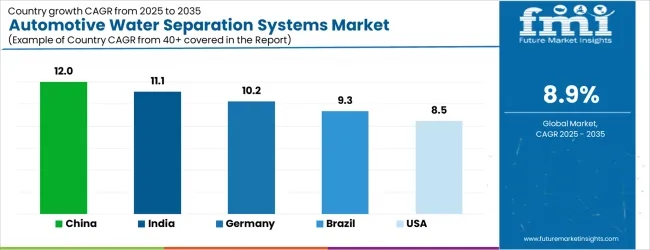
| Country | CAGR |
|---|---|
| China | 12.0% |
| India | 11.1% |
| Germany | 10.2% |
| Brazil | 9.3% |
| USA | 8.5% |
| UK | 7.6% |
| Japan | 6.7% |
The Automotive Water Separation Systems Market is expected to register a CAGR of 8.9% during the forecast period, exhibiting varied country level momentum. China leads with the highest CAGR of 12.0%, followed by India at 11.1%. Developed markets such as Germany, France, and the UK continue to expand steadily, while the USA is likely to grow at consistent rates. Japan posts the lowest CAGR at 6.7%, yet still underscores a broadly positive trajectory for the global Automotive Water Separation Systems Market. In 2024, Germany held a dominant revenue in the Western Europe market and is expected to grow with a CAGR of 10.2%. The USA Automotive Water Separation Systems Market is estimated to be valued at USD 465.9 million in 2025 and is anticipated to reach a valuation of USD 465.9 million by 2035. Sales are projected to rise at a CAGR of 0.0% over the forecast period between 2025 and 2035. While Japan and South Korea markets are estimated to be valued at USD 68.3 million and USD 43.1 million respectively in 2025.
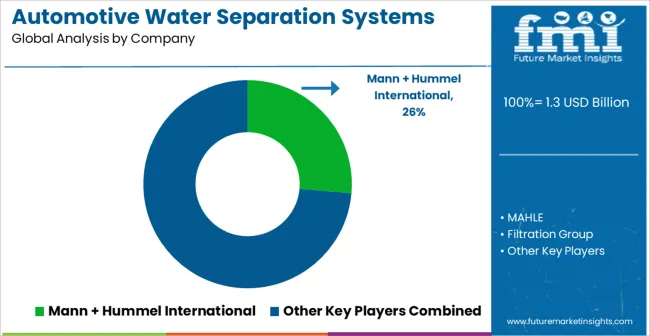
| Item | Value |
|---|---|
| Quantitative Units | USD 1.3 Billion |
| Sales Channel | Original Equipment Manufacturers (OEM), Original Equipment Supplier (OES), and Independent Aftermarket (IAM) |
| Vehicle Type | Passenger Car Automotive Water Separation Systems, LCV Automotive Water Separation Systems, and HCV Automotive Water Separation Systems |
| Regions Covered | North America, Europe, Asia-Pacific, Latin America, Middle East & Africa |
| Country Covered | United States, Canada, Germany, France, United Kingdom, China, Japan, India, Brazil, South Africa |
| Key Companies Profiled | Mann + Hummel International, MAHLE, Filtration Group, Donaldson, ELOFIC INDUSTRIES LIMITED, PARKER HANNIFIN CORP, Bosch, and Hollingsworth & Vose |
The global automotive water separation systems market is estimated to be valued at USD 1.3 billion in 2025.
The market size for the automotive water separation systems market is projected to reach USD 3.1 billion by 2035.
The automotive water separation systems market is expected to grow at a 8.9% CAGR between 2025 and 2035.
The key product types in automotive water separation systems market are original equipment manufacturers (oem), original equipment supplier (oes) and independent aftermarket (iam).
In terms of vehicle type, passenger car automotive water separation systems segment to command 50.0% share in the automotive water separation systems market in 2025.






Our Research Products

The "Full Research Suite" delivers actionable market intel, deep dives on markets or technologies, so clients act faster, cut risk, and unlock growth.

The Leaderboard benchmarks and ranks top vendors, classifying them as Established Leaders, Leading Challengers, or Disruptors & Challengers.

Locates where complements amplify value and substitutes erode it, forecasting net impact by horizon

We deliver granular, decision-grade intel: market sizing, 5-year forecasts, pricing, adoption, usage, revenue, and operational KPIs—plus competitor tracking, regulation, and value chains—across 60 countries broadly.

Spot the shifts before they hit your P&L. We track inflection points, adoption curves, pricing moves, and ecosystem plays to show where demand is heading, why it is changing, and what to do next across high-growth markets and disruptive tech

Real-time reads of user behavior. We track shifting priorities, perceptions of today’s and next-gen services, and provider experience, then pace how fast tech moves from trial to adoption, blending buyer, consumer, and channel inputs with social signals (#WhySwitch, #UX).

Partner with our analyst team to build a custom report designed around your business priorities. From analysing market trends to assessing competitors or crafting bespoke datasets, we tailor insights to your needs.
Supplier Intelligence
Discovery & Profiling
Capacity & Footprint
Performance & Risk
Compliance & Governance
Commercial Readiness
Who Supplies Whom
Scorecards & Shortlists
Playbooks & Docs
Category Intelligence
Definition & Scope
Demand & Use Cases
Cost Drivers
Market Structure
Supply Chain Map
Trade & Policy
Operating Norms
Deliverables
Buyer Intelligence
Account Basics
Spend & Scope
Procurement Model
Vendor Requirements
Terms & Policies
Entry Strategy
Pain Points & Triggers
Outputs
Pricing Analysis
Benchmarks
Trends
Should-Cost
Indexation
Landed Cost
Commercial Terms
Deliverables
Brand Analysis
Positioning & Value Prop
Share & Presence
Customer Evidence
Go-to-Market
Digital & Reputation
Compliance & Trust
KPIs & Gaps
Outputs
Full Research Suite comprises of:
Market outlook & trends analysis
Interviews & case studies
Strategic recommendations
Vendor profiles & capabilities analysis
5-year forecasts
8 regions and 60+ country-level data splits
Market segment data splits
12 months of continuous data updates
DELIVERED AS:
PDF EXCEL ONLINE
Water Softening Systems Market Analysis - Size, Share, and Forecast Outlook 2025 to 2035
Automotive Seating Systems Market Analysis - Size, Share & Forecast 2025 to 2035
Automotive Exhaust Systems Market Trends - Growth & Forecast 2025 to 2035
Automotive Ignition Systems Market Size and Share Forecast Outlook 2025 to 2035
Automotive Electric Water Pump for Engine Cooling Market Size and Share Forecast Outlook 2025 to 2035
Automotive Brake Actuation Systems Market Size and Share Forecast Outlook 2025 to 2035
Automotive Energy Recovery Systems Market Size and Share Forecast Outlook 2025 to 2035
Automotive Turbo Compounding Systems Market Growth – Trends & Forecast 2025 to 2035
Automotive Personal Navigation Systems Market Size and Share Forecast Outlook 2025 to 2035
Automotive Gesture Recognition Systems Market
Automotive Touch Screen Control Systems Market Growth - Trends & Forecast 2025 to 2035
ADAS Market Growth - Trends & Forecast 2025 to 2035
Sponge City Rainwater Management Systems Market Size and Share Forecast Outlook 2025 to 2035
Bioelectrochemical Systems For Wastewater Treatment Market Size and Share Forecast Outlook 2025 to 2035
Electronic Control Unit in Automotive Systems Market Size and Share Forecast Outlook 2025 to 2035
Automotive Direct Liquid Cooling IGBT Module Market Size and Share Forecast Outlook 2025 to 2035
Automotive Hoses and Assemblies Market Size and Share Forecast Outlook 2025 to 2035
Automotive Network Testing Market Size and Share Forecast Outlook 2025 to 2035
Water Vapor Permeability Analyzers Market Size and Share Forecast Outlook 2025 to 2035
Automotive Performance Part Market Size and Share Forecast Outlook 2025 to 2035

Thank you!
You will receive an email from our Business Development Manager. Please be sure to check your SPAM/JUNK folder too.
Chat With
MaRIA